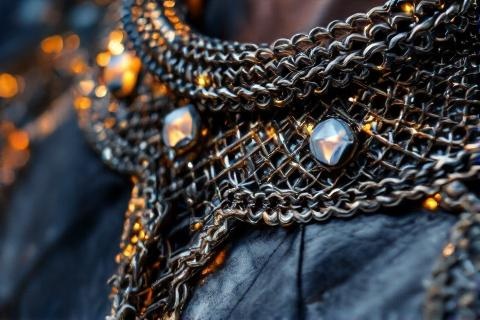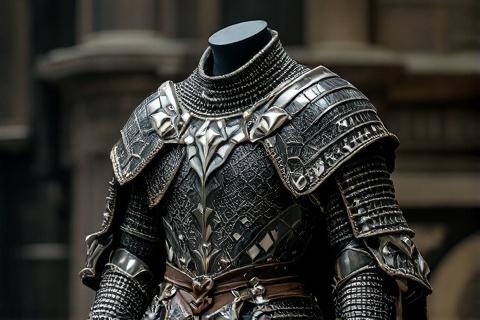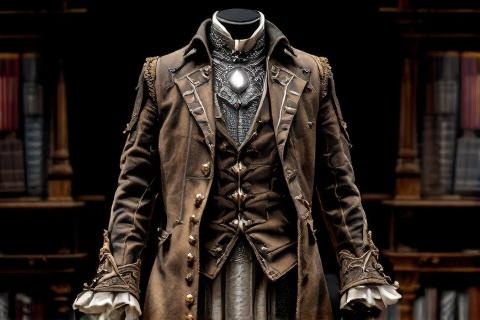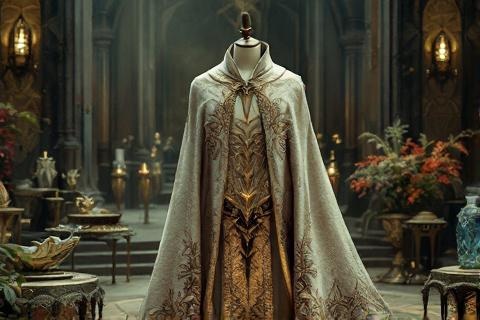
Mithril Coat of Bilbo Baggins
The Impossibly Light and Strong Dwarven Mail
A Treasure Beyond Price

The mithril coat stands as one of the most valuable gifts ever bestowed upon a
hobbit, presented to Bilbo Baggins
by Thorin Oakenshield during their quest to
reclaim Erebor. This extraordinary piece of armor represented
not just immense material wealth, but also symbolized the deep respect and
friendship that had grown between the dwarf king and the
burglar hobbit through their shared perils and adventures.
The coat was crafted from pure mithril, also known as true-silver, which was the
most precious metal known in Middle-earth. This
remarkable material was found only in the depths of
Khazad-dûm, making it rarer than gold and exponentially
more valuable. Even the smallest items made of mithril were considered priceless
treasures.
The true worth of this magnificent coat was almost beyond calculation, with
Gandalf later revealing to Frodo that it was worth more
than the entire Shire and everything in it combined. This staggering value
reflects not only the rarity of mithril but also the exceptional craftsmanship
involved in creating such a fine piece of armor.
The Nature of Mithril
The legendary mines of Khazad-dûm, later known as Moria, were the only source of
mithril in all of Middle-earth. The Dwarves of Durin's Folk
discovered this precious metal deep beneath the Misty Mountains, and their
mining of it brought them unprecedented wealth and power. The eventual awakening
of the Balrog and the abandonment of Khazad-dûm made mithril even more scarce
and valuable.
Despite being a form of metal armor, the mithril coat possessed remarkable
properties that made it uniquely practical. It weighed no more than a regular
silk shirt, allowing the wearer to move freely without the burden typically
associated with protective gear. Yet its defensive capabilities surpassed even
the finest steel armor, making it the perfect combination of comfort and
protection.
Mithril possessed an ethereal beauty that set it apart from all other precious
metals. It bore a resemblance to silver but with a more lustrous and pure
appearance that never dulled or tarnished over time. The metal retained its
brilliant sheen regardless of age or exposure to the elements, maintaining its
beauty through generations.
The exceptional qualities of mithril made it highly sought after by
Elves, Dwarves, and Men alike. The Elves particularly valued it
for its beauty and incorporated it into their most precious works, while the
Dwarves prized it above all other metals for both its practical and aesthetic
properties. Even the Númenóreans of old coveted mithril,
with their kings wearing armor and helms made from this precious metal.
Craftsmanship and Design

The mithril coat was forged by the master craftsmen of Erebor, demonstrating the
height of dwarven metallurgy and artistic skill. These smiths were renowned
throughout Middle-earth for their ability to work with precious metals, creating
items of both practical use and stunning beauty. Their expertise in working with
mithril represented the pinnacle of their craft.
Originally designed to fit a young elf-prince, the coat's dimensions proved
fortuitously perfect for a hobbit's frame. This coincidence allowed Bilbo to
wear the armor comfortably without any alterations, as though it had been made
specifically for him. The size of the coat would later prove equally suitable
for Frodo, continuing its legacy of protecting Baggins family members.
The craftsmen who created the coat adorned it with exquisite decorative elements
that elevated it beyond mere armor. The collar was beautifully embellished with
white gems and crystal, showcasing the dwarven mastery of both metalwork and
gemcraft. These decorative elements transformed the coat into a piece of jewelry
as much as armor, reflecting the dwarven preference for combining beauty with
functionality.
From Erebor to Bag End
Before coming into Bilbo's possession, the mithril coat was part of the vast
treasure hoard of Erebor, the Lonely Mountain. This legendary collection of
wealth, accumulated over generations of dwarven kings, contained countless
precious items, yet the mithril coat stood out as one of its most valuable
pieces. It survived the long years of Smaug's occupation,
remaining untarnished despite the dragon's presence.
Thorin Oakenshield presented the coat to Bilbo in a moment of clarity before the
Battle of Five Armies, recognizing the hobbit's
loyalty and friendship despite their recent disagreements. This gift represented
a significant gesture from Thorin, who had been struggling with dragon-sickness
and its effects on his judgment. The giving of such a precious item showed
Thorin's true character emerging from the shadow of gold-lust.
Following his return to the Shire, Bilbo kept the mithril coat safely hidden in
Bag End for many years. Few in the Shire knew of its existence, and fewer still
understood its true value or significance. The coat remained a private reminder
of Bilbo's adventures, stored away with other mementos of his journey to the
Lonely Mountain.
A Secret of Great Power

Throughout his adventures, Bilbo wore the mithril coat underneath his regular
clothing, creating an invisible layer of protection that few suspected. This
concealment suited both practical purposes and the hobbit's modest nature,
allowing him to maintain a relatively inconspicuous appearance while benefiting
from unparalleled protection.
The coat proved its worth multiple times during Bilbo's adventures, protecting
him from potentially fatal blows and attacks. Its incredible strength allowed
Bilbo to survive situations that would have proved lethal to someone wearing
ordinary armor or no armor at all. The lightweight nature of the coat meant he
could wear it constantly without fatigue.
Most hobbits in the Shire remained unaware of the true nature and value of
Bilbo's mithril coat. While rumors circulated about Bilbo's wealth and strange
artifacts from his adventures, the existence of this priceless piece of armor
remained largely unknown. This ignorance helped maintain Bilbo's privacy and
prevented unwanted attention to his valuable possession.
Legacy to Frodo
In a moment of great significance at Rivendell, Bilbo passed the mithril coat to
Frodo before the younger hobbit embarked on his perilous quest to destroy the
One Ring. This transfer of the coat symbolized not only
Bilbo's love for his heir but also the passing of the torch from one adventuring
Baggins to another. The gift demonstrated Bilbo's wisdom in understanding that
Frodo would need every possible advantage in his dangerous journey.
During Frodo's quest to destroy the One Ring, the mithril coat repeatedly proved
its worth by protecting him from deadly attacks. Most notably, it saved his life
in the Chamber of Mazarbul in Moria, where it prevented what would have been a
fatal blow from a cave troll's spear. The coat's incredible resilience amazed
even the Fellowship, particularly
Aragorn and Gandalf, who recognized the true
value of such protection.
The mithril coat's protection of Frodo demonstrated the enduring value of
Thorin's gift across generations of Baggins family members. What began as a
gesture of friendship between a dwarf king and a burglar hobbit continued to
serve the free peoples of Middle-earth in their greatest hour of need. The
coat's journey from Bilbo to Frodo represented the interconnected nature of
their quests and the continuing importance of seemingly chance gifts.
Cultural Impact and Symbolism

The mithril coat stands as a lasting symbol of the unique friendship that
developed between the dwarves and hobbits, particularly through the relationship
of Thorin Oakenshield and Bilbo Baggins. This connection, forged through shared
adventures and mutual respect, helped bridge the gap between two very different
cultures and established a lasting bond between their peoples.
The coat exemplifies the dwarven mastery of combining practical utility with
artistic beauty. While primarily serving as protective armor, its elegant design
and decorative elements showcase the sophisticated aesthetic sensibilities of
dwarven craftsmanship. This harmonious blend of function and form represents the
height of dwarven cultural achievements.
Throughout the history of Middle-earth, seemingly small things often proved to
have great significance, and the mithril coat is a prime example of this theme.
Though small enough to fit a hobbit, its value and importance far exceeded its
size, much like the hobbits themselves who played crucial roles in the great
events of their age.
Above all, the mithril coat serves as a powerful reminder that true friendship
and loyalty hold greater value than material wealth. While the coat itself was
worth more than the entire Shire, its greatest worth lay in its role as a symbol
of trust and fellowship between different peoples of Middle-earth. This lesson
resonates throughout both Bilbo's and Frodo's stories, underlining one of
Tolkien's central themes about the superior worth of friendship and courage over
gold and jewels.
